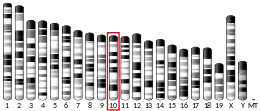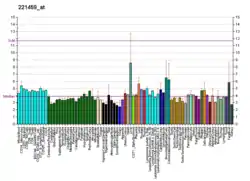| TAAR5 | |||||||||||||||||||||||||||||||||||||||||||||||||||
|---|---|---|---|---|---|---|---|---|---|---|---|---|---|---|---|---|---|---|---|---|---|---|---|---|---|---|---|---|---|---|---|---|---|---|---|---|---|---|---|---|---|---|---|---|---|---|---|---|---|---|---|
| Identifiers | |||||||||||||||||||||||||||||||||||||||||||||||||||
| Aliases | TAAR5, PNR, trace amine associated receptor 5, taR-5 | ||||||||||||||||||||||||||||||||||||||||||||||||||
| External IDs | OMIM: 607405 MGI: 2685073 HomoloGene: 20850 GeneCards: TAAR5 | ||||||||||||||||||||||||||||||||||||||||||||||||||
| |||||||||||||||||||||||||||||||||||||||||||||||||||
| |||||||||||||||||||||||||||||||||||||||||||||||||||
| |||||||||||||||||||||||||||||||||||||||||||||||||||
| |||||||||||||||||||||||||||||||||||||||||||||||||||
| |||||||||||||||||||||||||||||||||||||||||||||||||||
| Wikidata | |||||||||||||||||||||||||||||||||||||||||||||||||||
| |||||||||||||||||||||||||||||||||||||||||||||||||||
Trace amine-associated receptor 5 is a protein that in humans is encoded by the TAAR5 gene.[5][6][7] In vertebrates, TAAR5 is expressed in the olfactory epithelium.[8]
Human TAAR5 (hTAAR5) is a functional trace amine-associated receptor which acts as an olfactory receptor for tertiary amines.[8][9] Trimethylamine and N,N-dimethylethylamine are full agonists of hTAAR5.[9][10][11] The amber-woody fragrance timberol antagonizes this activity of trimethylamine.[12] 3-Iodothyronamine is an inverse agonist of hTAAR5.[13][14] Recent studies highlighted the significant role of TAAR5 in the central nervous system and periphery. Beta-galactosidase mapping of TAAR5 expression showed its localization not only in the glomeruli but also in deeper layers of olfactory bulb projecting to the limbic brain olfactory circuitry. Moreover, TAAR5 knockout mice show increased adult neurogenesis and elevated number of dopamine neurons. Also, it was observed statistically significant changes in osmotic erythrocyte fragility in TAAR5-KO mice.[15]
Mutations in the TAAR5 gene were found to affect human olfaction. Icelanders with a mutation in the gene were less likely to describe fish smell containing trimethylamine as unpleasant, and described licorice odor and cinnamon odor more intensely.[16]
See also
References
- 1 2 3 GRCh38: Ensembl release 89: ENSG00000135569 - Ensembl, May 2017
- 1 2 3 GRCm38: Ensembl release 89: ENSMUSG00000069706 - Ensembl, May 2017
- ↑ "Human PubMed Reference:". National Center for Biotechnology Information, U.S. National Library of Medicine.
- ↑ "Mouse PubMed Reference:". National Center for Biotechnology Information, U.S. National Library of Medicine.
- ↑ Zeng Z, Fan P, Rand E, Kyaw H, Su K, Madike V, Carter KC, Li Y (March 1998). "Cloning of a putative human neurotransmitter receptor expressed in skeletal muscle and brain". Biochem Biophys Res Commun. 242 (3): 575–8. doi:10.1006/bbrc.1997.7591. PMID 9464258.
- ↑ Lindemann L, Ebeling M, Kratochwil NA, Bunzow JR, Grandy DK, Hoener MC (February 2005). "Trace amine-associated receptors form structurally and functionally distinct subfamilies of novel G protein-coupled receptors". Genomics. 85 (3): 372–85. doi:10.1016/j.ygeno.2004.11.010. PMID 15718104.
- ↑ "Entrez Gene: TAAR5 trace amine associated receptor 5".
- 1 2 Liberles SD (2015). "Trace amine-associated receptors: ligands, neural circuits, and behaviors". Curr. Opin. Neurobiol. 34: 1–7. doi:10.1016/j.conb.2015.01.001. PMC 4508243. PMID 25616211.
All TAARs except TAAR1 function as olfactory receptors, based on studies in rodent, primate, and fish [4,7,10]. TAAR expression is highly enriched in the olfactory system by quantitative PCR (qPCR) analysis, with little or no expression in other tissues examined [4].
- 1 2 Zhang LS, Davies SS (April 2016). "Microbial metabolism of dietary components to bioactive metabolites: opportunities for new therapeutic interventions". Genome Med. 8 (1): 46. doi:10.1186/s13073-016-0296-x. PMC 4840492. PMID 27102537.
Table 2: Microbial metabolites: their synthesis, mechanisms of action, and effects on health and disease
Figure 1: Molecular mechanisms of action of indole and its metabolites on host physiology and disease - ↑ Wallrabenstein I, Kuklan J, Weber L, Zborala S, Werner M, Altmüller J, Becker C, Schmidt A, Hatt H, Hummel T, Gisselmann G (2013). "Human trace amine-associated receptor TAAR5 can be activated by trimethylamine". PLOS ONE. 8 (2): e54950. Bibcode:2013PLoSO...854950W. doi:10.1371/journal.pone.0054950. PMC 3564852. PMID 23393561.
- ↑ Zhang J, Pacifico R, Cawley D, Feinstein P, Bozza T (February 2013). "Ultrasensitive detection of amines by a trace amine-associated receptor". J. Neurosci. 33 (7): 3228–39. doi:10.1523/JNEUROSCI.4299-12.2013. PMC 3711460. PMID 23407976.
We show that [human TAAR5] responds to the tertiary amine N,N-dimethylethylamine and to a lesser extent to trimethylamine, a structurally related agonist for mouse and rat TAAR5 (Liberles and Buck, 2006; Staubert et al., 2010; Ferrero et al., 2012).
- ↑ Wallrabenstein I, Singer M, Panten J, Hatt H, Gisselmann G (2015). "Timberol® Inhibits TAAR5-Mediated Responses to Trimethylamine and Influences the Olfactory Threshold in Humans". PLOS ONE. 10 (12): e0144704. Bibcode:2015PLoSO..1044704W. doi:10.1371/journal.pone.0144704. PMC 4684214. PMID 26684881.
While mice produce gender-specific amounts of urinary TMA levels and were attracted by TMA, this odor is repellent to rats and aversive to humans [19], indicating that there must be species-specific functions. ... Furthermore, a homozygous knockout of murine TAAR5 abolished the attraction behavior to TMA [19]. Thus, it is concluded that TAAR5 itself is sufficient to mediate a behavioral response at least in mice. ... Whether the TAAR5 activation by TMA elicits specific behavioral output like avoidance behavior in humans still needs to be examined.
- ↑ Dinter J, Mühlhaus J, Wienchol CL, Yi CX, Nürnberg D, Morin S, Grüters A, Köhrle J, Schöneberg T, Tschöp M, Krude H, Kleinau G, Biebermann H (2015). "Inverse agonistic action of 3-iodothyronamine at the human trace amine-associated receptor 5". PLOS ONE. 10 (2): e0117774. Bibcode:2015PLoSO..1017774D. doi:10.1371/journal.pone.0117774. PMC 4382497. PMID 25706283.
- ↑ Khan MZ, Nawaz W (October 2016). "The emerging roles of human trace amines and human trace amine-associated receptors (hTAARs) in central nervous system". Biomed. Pharmacother. 83: 439–449. doi:10.1016/j.biopha.2016.07.002. PMID 27424325.
- ↑ Zhukov IS, Kubarskaya LG, Karpova IV, Vaganova AN, Karpenko MN, Gainetdinov RR (July 2021). "Minor Changes in Erythrocyte Osmotic Fragility in Trace Amine-Associated Receptor 5 (TAAR5) Knockout Mice". International Journal of Molecular Sciences. 22 (14): 7307. doi:10.3390/ijms22147307. PMC 8303310. PMID 34298937.
- ↑ Gisladottir RS, Ivarsdottir EV, Helgason A, Jonsson L, Hannesdottir NK, Rutsdottir G, Arnadottir GA, Skuladottir A, Jonsson BA, Norddahl GL, Ulfarsson MO, Helgason H, Halldorsson BV, Nawaz MS, Tragante V (December 2020). "Sequence Variants in TAAR5 and Other Loci Affect Human Odor Perception and Naming". Current Biology. 30 (23): 4643–4653.e3. doi:10.1016/j.cub.2020.09.012. ISSN 0960-9822. PMID 33035477. S2CID 222213583.
Further reading
- Strausberg RL, Feingold EA, Grouse LH, et al. (2003). "Generation and initial analysis of more than 15,000 full-length human and mouse cDNA sequences". Proc. Natl. Acad. Sci. U.S.A. 99 (26): 16899–903. Bibcode:2002PNAS...9916899M. doi:10.1073/pnas.242603899. PMC 139241. PMID 12477932.
- Mungall AJ, Palmer SA, Sims SK, et al. (2003). "The DNA sequence and analysis of human chromosome 6". Nature. 425 (6960): 805–11. Bibcode:2003Natur.425..805M. doi:10.1038/nature02055. PMID 14574404.
- Gerhard DS, Wagner L, Feingold EA, et al. (2004). "The Status, Quality, and Expansion of the NIH Full-Length cDNA Project: The Mammalian Gene Collection (MGC)". Genome Res. 14 (10B): 2121–7. doi:10.1101/gr.2596504. PMC 528928. PMID 15489334.
This article incorporates text from the United States National Library of Medicine, which is in the public domain.




